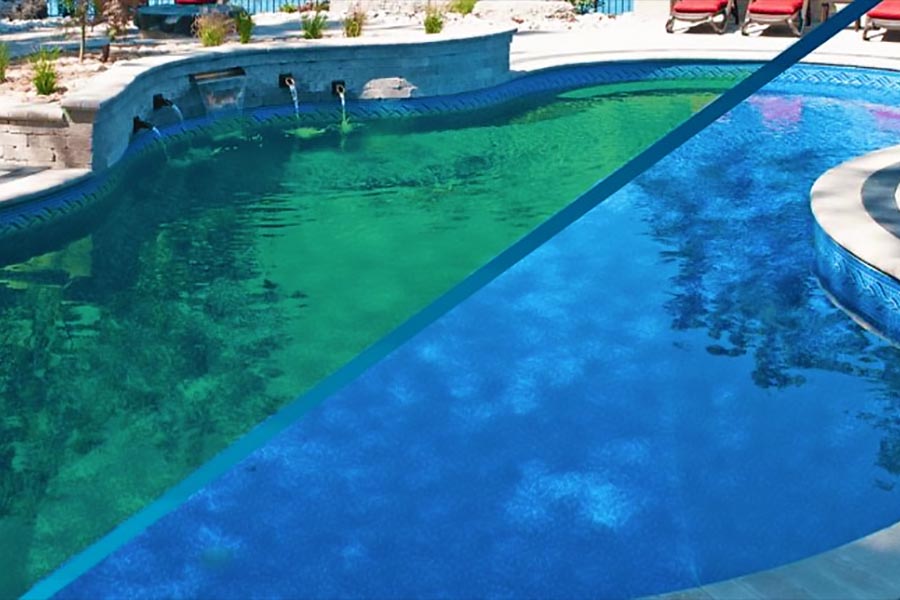Helpful Pool & Spa Advice

Tips for Preventing Algae Growth in Your Pool
Algae growth is one of the most common issues pool owners face, but it can be prevented with proactive maintenance and the right strategies. Algae can quickly turn a clean, inviting pool into a murky, unusable mess if not managed effectively. In this article, we'll dive into advanced techniques for keeping your pool algae-free by focusing on water chemistry, circulation, and equipment efficiency.
1. Maintain Proper Water Chemistry Consistently
The most crucial step in preventing algae growth is keeping your pool's water chemistry balanced. Algae thrives in water with low sanitizer levels, so ensure your chlorine levels stay between 2-4 ppm. For those using a saltwater system, ensure the salt chlorine generator is working efficiently to maintain consistent chlorine output. Additionally, monitoring pH levels is critical. A pH range of 7.2-7.6 ensures that chlorine remains effective at killing algae spores.
- Keep chlorine levels stable between 2-4 ppm.
- Maintain pH levels within the 7.2-7.6 range to optimize chlorine effectiveness.
- Regularly test water chemistry, especially after heavy use or rainfall.
2. Enhance Circulation to Eliminate Stagnant Areas
Algae tends to form in areas where water circulation is poor, such as corners or behind steps. Advanced pool owners can optimize circulation by adjusting the direction of return jets to promote better water flow throughout the pool. Adding booster pumps or strategically placing additional return lines can help eliminate these dead spots. A well-optimized circulation system ensures that sanitizers reach every part of the pool, making it difficult for algae to take hold.
- Adjust return jets to improve water circulation in dead spots.
- Consider installing booster pumps to enhance overall flow.
- Monitor circulation patterns after adjustments to ensure effectiveness.
3. Optimize Your Filtration System
A high-performing filtration system is key to keeping your pool water clean and free of algae spores. To optimize your filter's efficiency, backwash or clean it regularly, as dirty filters can slow circulation and allow algae to flourish. Depending on your pool's design and usage, consider upgrading to a DE filter or a high-efficiency cartridge filter, both of which offer superior filtration compared to standard sand filters. For larger pools or those in high-debris areas, adding a secondary filter can provide an extra layer of protection.
- Regularly backwash or clean filters to maintain efficiency.
- Upgrade to a DE filter or high-efficiency cartridge filter for superior filtration.
- Consider a dual filtration system for enhanced debris removal.
4. Use an Algaecide Preventatively
While algaecides are typically used to combat existing algae, they can also be applied preventatively. A copper-based algaecide can be especially effective in keeping algae at bay, particularly during peak swimming season or after heavy rain, which can introduce contaminants that encourage algae growth. However, it’s important to choose an algaecide that doesn’t interfere with your pool’s chemical balance, especially if you have sensitive equipment or are using a saltwater system.
- Use a copper-based algaecide during periods of heavy pool usage or after storms.
- Apply preventatively to avoid algae outbreaks, rather than waiting for issues to arise.
- Ensure the algaecide is compatible with your filtration system and sanitizers.
5. Brush the Pool Regularly
Even with well-balanced water chemistry, brushing the pool's walls and floor is essential to physically disrupt algae spores before they can settle. Pay special attention to shaded areas and locations where water circulation may be weaker. Brushing should be done at least once a week, particularly in corners, behind ladders, and along the steps, where algae tends to start.
- Brush pool walls, floors, and shaded areas weekly to prevent algae buildup.
- Focus on hard-to-reach areas like corners and steps.
- Use a nylon brush for delicate surfaces or a steel brush for tougher algae spots.
6. Utilize Phosphate Removers
Phosphates serve as a nutrient source for algae, so limiting their presence in your pool can significantly reduce algae growth. High phosphate levels can come from debris, fertilizers, or even tap water. Using a phosphate remover as part of your regular maintenance routine can prevent algae from thriving, especially during seasons when organic debris is more likely to enter the pool.
- Test for phosphate levels regularly, especially after storms or heavy debris.
- Use a phosphate remover to eliminate the nutrients algae need to grow.
- Monitor phosphate levels consistently to keep them below 100 ppb.
7. Keep Your Pool Covered When Not in Use
One of the simplest yet most effective ways to prevent algae growth is by using a pool cover when the pool is not in use. A solar cover not only retains heat but also reduces the amount of organic matter, such as leaves or insects, entering the pool. Reducing debris means fewer contaminants that encourage algae growth. For extended periods of non-use, consider using a mesh safety cover to block out light and debris while allowing water to drain through.
- Use a solar cover to retain heat and minimize debris entry.
- For long-term coverage, opt for a mesh safety cover to prevent sunlight and debris from promoting algae growth.
- Ensure covers are cleaned regularly to prevent contamination when removed.
Key Points:
- Consistently monitor and balance water chemistry, particularly chlorine and pH levels.
- Optimize circulation by adjusting jets or adding booster pumps.
- Maintain and upgrade your filtration system for better debris removal.
- Use algaecides preventatively and regularly brush the pool.
- Implement phosphate removers to limit algae nutrients and keep the pool covered when not in use.

